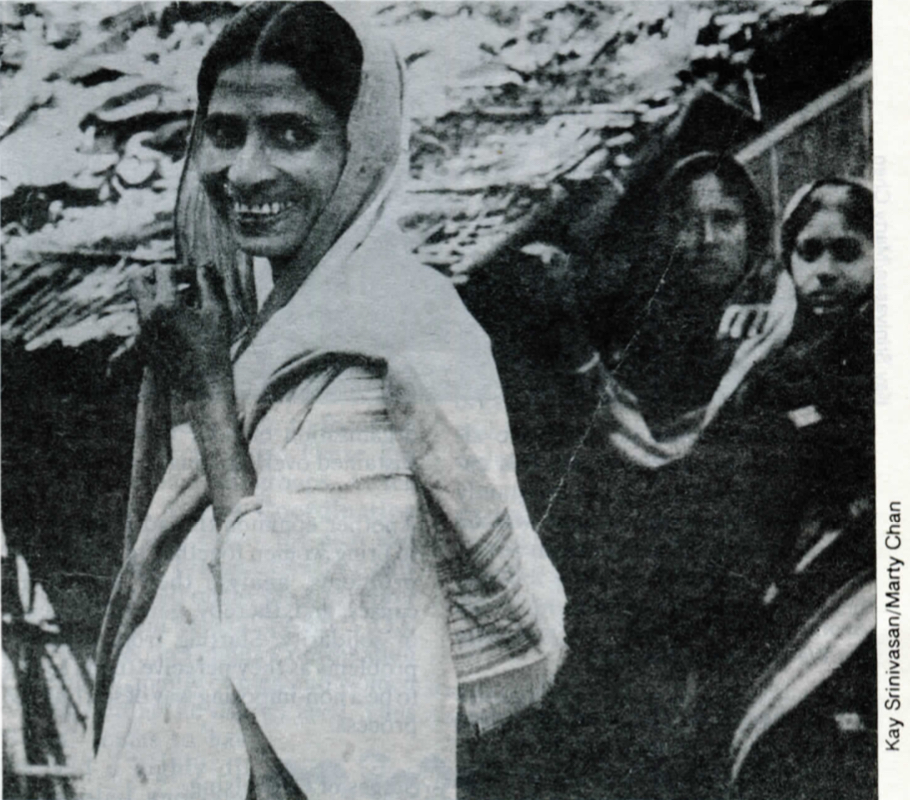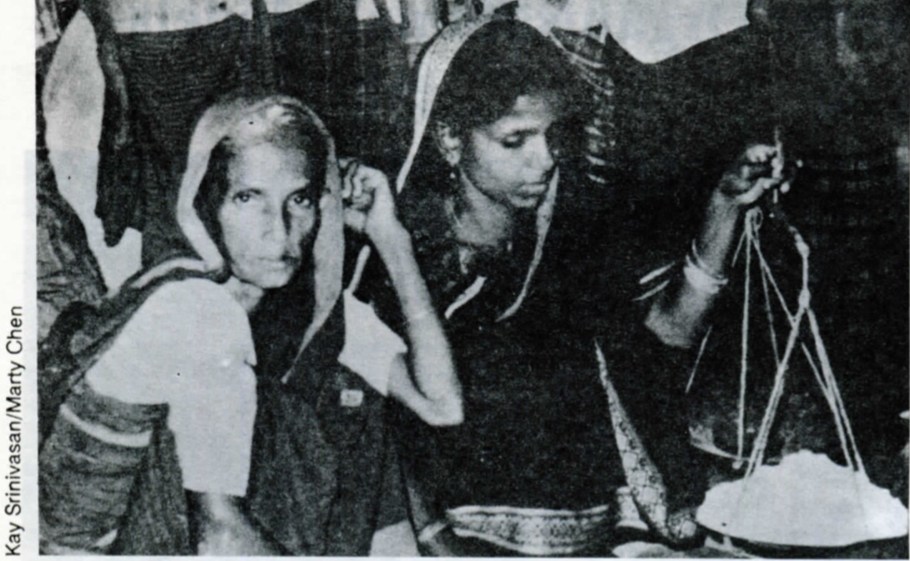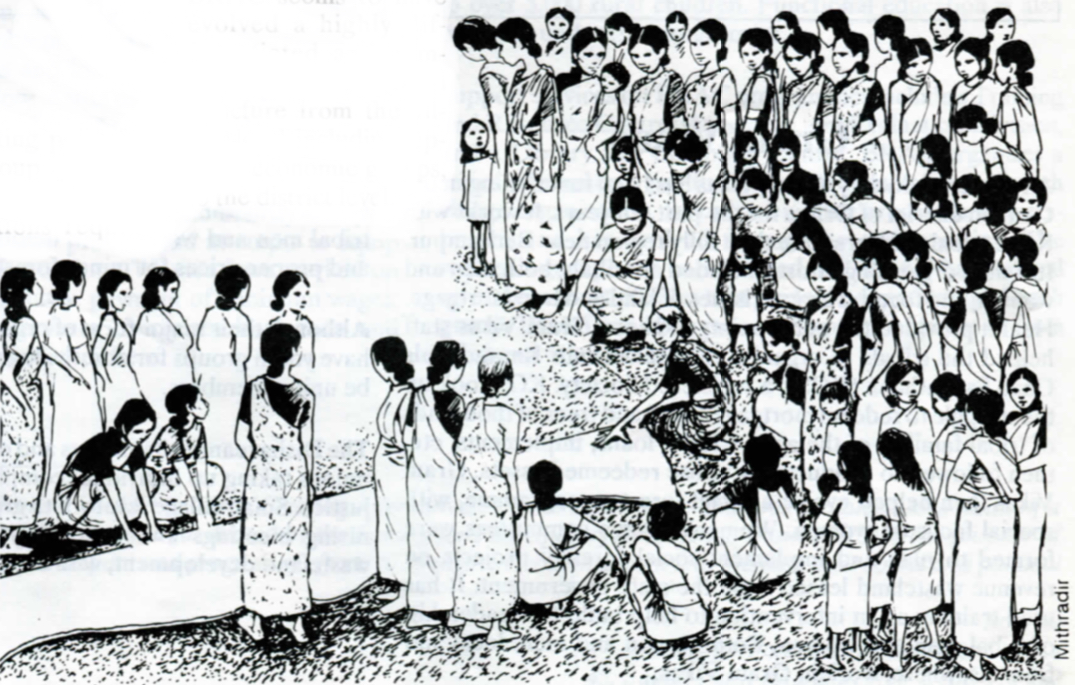Empowering Women: Organisational Models
Society for Participatory Research in Asia
Enhancing economic security of poor women and strengthening women's work entails strategies of organising women as well. While some organising of women is done in most economic programmes (thrift societies, cooperatives, Mahila Mandals, etc.), organising women for empowerment is crucial for sustained improvements in their economic status in the long run.
In organising poor women (rural and urban), several different models are being used in practice, both around economic and social issues. The process of organising poor women can vary. Some of the l«ey aspects of organising are highlighted here, based on the analysis of case studies (see end of article).
Whom Should One Organise?
An issue of initial concern is whom to organise? Should one organise women separately, or men and women together? Women need to be organised separately, at least initially. This is essential for several reasons:
• Women need to develop their self-confidence and identity, and this requires time and space away from men; separateness provides opportunities for expression, articulation and relating to each other as women;
• Women's values and attitudes are different, and organising them separately can highlight these values as alternative bases in organisations.

However, both class and gender issues need to be the focus of organising. We need to organise poor women separately; we also need to organise poor men, and we need to create the opportunity for their coming together as well.
The actual mode and form of separate and joint organising will vary from place to place. Both separate organising for women's and joint organising with men's organisations may be necessary. But in the course of the movement, both men and women need to be organised.
If we Took at five cases, three models emerge:
- Men and women are organised separately initially, later they are brought together (Astha, BRAC)
- Only women are organised (SEWA)
- Men and women are jointly organised; later special emphasis is placed on women (Gram Vikas, Disha).
Experience shows that in some areas organising women may be possible only after an initial briefing of men (backward areas of Rajasthan, Uttar Pradesh, Bihar, Madhya Pradesh, etc.).
An interesting note of caution must be raised: women are often very central during the early stages of building a movement; but when an organisation is subsequently formed, they are sidelined (Gram Vikas shared this experience also). This is to be constantly mentioned, otherwise women will be exploited by the movement too.

Around What Issue(s) Do We Organise Women?
What should be the starting issues around which women should be organised? Several approaches are used. The initial coming together of a women's group is generally to share and analyze the problems they face. This throws up certain key issues: health, money lending, drinking water, etc. These become the entry issues for organising women. Some organising efforts have a general thrust initially as well. For example, BRAC brings in functional, non-formal education early on; Astha focuses on self-help thrift societies. Some others focus on economic issues directly: Disha focuses on wages for labourers and prices for minor forest produce collectors; SEWA on women's work (credit, asset creation, etc.).
Different starting issues are possible; but economic issues (wages, income, livelihood, employment, work, etc.) need to be addressed early on if the organisation ol poor women is to be sustained over the long run.
Another common thread seems to be to bring women together to share their problems, analyse their underlying causes, and, thereby, generate a sense of solidarity. Starting from women's problems as they perceive them, seems to be a non-imposing way of starting the process.
Stages of Organising
The process of organising goes through several stages; that is, organising is not a one-shot process. These stages seem to characterise a series of shifts: from simpler to more complex issues, from learning to doing, from simple groups to more elaborate organisational structures, from local action to broader actions.
The initial step of organising focuses on some immediate, tangible gain which tends to sustain the motivation for future organising; the organising process becomes easy if the focus is on an identifiable benefit.
The training of leaders is an important intermediate step; cadre-building and strengthening local leadership to take
responsibility for the organisation is a crucial stage in the process; this training ensures the long-term viability of women's organisations, managed by those women themselves.
The sustenance of organisations demands struggle on issues of common concern; it further demands developmental actions, as mere struggle is unable to further strengthen the organisation; action may entail women doing some things together—joint production or marketing, poor group credit operation, etc.
Further strengthening of organisation entails broadening the constituency to include various types of similar groups (this is when men's groups, youth clubs, etc. are brought together with women's organisations for sustained action). This is where class-based organisational linkages with other similar organisations acquire salience.
Some cases highlight the elaborate stages through which the organisation building process proceeds. BRAC is particularly interesting in this respect.
Forms of Organising
The process of organising is also affected by the particular legal form that is used. Several different legal forms are available: society, trust, union, company, cooperative, etc. Some prefer an unregistered form for an initial period, as it provides greater flexibility and the least procedural requirements. But organisations needing external resources and legitimacy may require registration to become a legal entity. Then they have to choose a certain legal form for incorporation.
In the cases presented, several variations are visible. Astha preferred unregistered groups as long as feasible; then a Society as a form seemed least cumbersome to manage. The level of organisation was a hamlet (a cluster of 20-30 households of homogenous people). In the case of Gram Vikas, village committees and zonal bodies (comprising 7-10 villages) are not registered; the overall people's organisation is registered as a Society. SEWA and Disha use multiple forms of organisation. SEWA is mainly a trade union, comprising various trade groups; it also has a few production cooperatives for experimentation on economic viability of activities and alternative work for women. Disha is also a trade union of forest gatherers of minor forest produce and workers in the Forest Department; it has youth clubs comprising other poor villagers who are not eligible for Union membership registered as a Trust. BRAC is similar to Astha — they organise unregistered groups, but have worked out elaborate rules and procedures which govern the functioning of these groups.
The combination of a Union with another legal form seems to be particularly powerful as unionisation seems to create a strong basis for solidarity and collective action. It is also a form most appropriate for wider coverage and struggle. Other forms, like a Cooperative or Trust, can complement this form.
Federating?
It is clear that the starting point for organising is a small group — a few workers, a hamlet, a set of households. But stronger organisations require larger federating. The experience of the groups examined here clearly demonstrates the importance of federating to tackle larger issues. But forms and ways of federating differ.
The preferred model (Astha, Gram Vikas, Disha) seems to be issue-based federating at the district and state
levels. This ensures coming together around common issues, yet maintaining autonomous organizational identity. Likewise, SEWA has also been struggling to maintain its unique identity in relation to existing trade union federations, nationally and internationally. Yet, SEWA has a federation of eight separate local SEW As, and it is one union of several separate trade groups, which are organised separately.
BRAC is the only example of a long-term, ongoing federating structure based on geographical considerations. Their base unit is Village Organisation (V.O.) separate for men and women in the village. Separate production/economic groups of 10-30 women are formed within each V.O. to focus on economic aspects only. These are called operational sub-groups. At the Union level, Union Coordination Committees (separately for men and women earlier, brought together only later) are formed on the basis of representation from several (7-10) V.O.s. Only in 1986, an Upajila Coordination Committee, jointly of men and women was formed at the district level. Thus BRAC seems to have evolved a highly differentiated and complex organisational structure from the village level, including separate economic groups, to the district level.

Who are the Organisers?
In describing various models of organising poor women, it is also useful to understand who the organisers are. The cases presented here clearly show that outside catalytic agents act as initial organisers. These are men and women who are literate, conscious, committed and who deliberately make efforts at organising poor women. The presence of such persons as organisers is a common feature in all the cases.
The cases also show that some women from among the poor women being organised soon become important organisers as well. In fact, conscious and deliberate efforts to make local women organisers is needed to sustain this process of organising and ensures a larger cadre of organisers.
Clearly, these two broad types of organisers need to be able to work together as a team for effective organising — an external catalyst and a local organiser.
The issue of men as organisers has also been raised. Can men play the role of organising poor women? Experience shows that men can be good organisers, but they need special sensitivity to, and understanding of, women's needs and concerns in order to play this role effectively.
Conscious preparation, on an ongoing basis, of organisers is crucial to strengthen the process of organising poor women.
Conclusion
The stock-taking, reflections and analyses around issues of poor women's work, employment and livelihood, income and economic security have helped in the consolidation of our experiences and building of a collective knowledge base. We have gained the following insights:
- The importance of influencing public policy, as an integral and deliberate part of our grassroots work with poor women;
- The need to develop in-depth understanding of, and skills in, various models of organising poor women for empowerment;
- The relevance of constantly analysing our practice, of conceptualising the nature of work poor women are engaged in, and deriving principles from that conceptualisation to guide our future practice;
- The complexity and difficulty of enhancing the economic status of poor women, of increasing their economic security, and of assisting in the process of their empowerment.
It is this experience that can now strengthen our collective efforts to pursue our common mission, in different parts of India and Bangladesh and elsewhere.

Gram Vikas
A registered Society, Gram Vikas has been functioning in the Ganjam district of Orissa for the past ten years. It works with Kond tribals of Kerandimals, a hilly region near Berhampur. Its initial organising efforts included all tribals, both men and women, and focused around issues of land and tree mortgage. Health provided the entry point, and soon Gram Vikas staff helped the tribals to organise themselves into Kerandimals Gana Sangathana (KGS), a registered Society. KGS took up the struggle to redeem mortgaged land and trees of thousands of tribal families of the area. Credit, loans, implements, etc. then followed to productively utilise redeemed assets. Gram Vikas then helped evolve a social forestry programme, with special focus on women. Women's village committees were formed to plan and implement social forestry projects on revenue wasteland leased from the state government. It has used training as an intervention to help build the leadership of tribal men and women. Both women and men, local and from elsewhere, work in Gram Vikas.
Disha
Registered as a Trust, Disha has been working in the eastern belt of Gujarat. It has been mainly involved in organising tribal men and women into unions to get minimum wages and proper prices for minor forest produce collectors.
Although their major form of organising is unions, they also have youth groups for other villagers who are not eligible to be union members.
The Disha team visits villages and organises the villagers into unions taking up individual complaints in an effort to seek justice. Small village level youth groups are formed by organising meetings and concretely planning activities, like wasteland development, with them.
SEWA
Self Employed Women's Association (SEWA) has been registered as a union since 1972 and works mainly in the urban and rural areas around Ahmedabad, Gujarat. SEWA has been mainly working to achieve self-reliance, self-esteem and visibility of self-employed women.
Twenty-six thousand members of SEWA are mainly petty vendors and traders, home-based skilled workers and manual service providers in urban and rural areas.
SEWA also has a few production cooperatives for experimentation on economic viability of activities and alternative work for women. SEWA also has its own cooperative bank. SEWA organises women according to their trade groups to fightf or their demands. Normally they take up direct action but at times they have also appealed to the courts. Members of SEWA are also involved in lobbying for policy changes, both at the state and central level.
Astha This is a non-governmental organisation based in Udaipur district of Rajasthan. Its staff has been organising tribal women and women into self-help thrift societies at the hamlet level. Initial door-to-door contact with women is followed by an orientation of village men; and a group meeting of women is then convened. The problem faced by women, analysis of causes of these problems and identification of problems for collective action then follow. Astha uses awareness camps and short-duration training programmes to strengthen women's groups and their leadership. It prefers registered women's groups as long as possible as this provides necessary flexibility. The identification of appropriate economic activity and projects by poor women is a slow process and attempts to equip women to explore different options. Women have worked on issues of social forestry, poultry, payment of minimum wages, etc. Astha's team of organisers comprises both men and women, from local areas and elsewhere.
BRAC Bangladesh Rural Advancement Committee (BRAC) is one of the oldest NGOs of Bangladesh. Its total staff of 2,500 is involved in a variety of programmes and activities which can be described in four broad categories:
- General rural development programmes
- Education programmes
- Health programmes
Support services and other activities
Under the general rural development programmes, BRAC has four integrated rural development programmes each with a slightly different component of activities and targets. Through this, they have up to now organised over 2,500 self-reliant groups in some 1,500 villages. Marketing outlets for rural products and para legal services are some of the other programmes.
Health programmes include the oral therapy extension programme through which they have so far reached over seven million households in Bangladesh. The child survival programme is another component of the health programme.
Education programmes include non-formal primary education through which they have already provided education to over 5,000 rural children. Functional education is also taken up under this programme.
Support services for BRAC programmes include a Training and Resource Centre, Reasearch and Evaluation Division, and a Library and Computer Centre. BRAC organises a series of women's production subgroups as part of each village organisation. Its cadre-building process is very elaborate and has evolved through its own practice. The women's groups are unregistered, but BRAC has evolved an elaborate set of rules that guide the functioning of each group. BRAC has both men and women organisers, from local and other areas.
This article is an excerpt from a booklet entitled "Creating Alternatives: Women and Work" that was produced as a workshop held by OXFAM America and facilitated by the Society for Participatory Research in India (PRIA). The purpose the workshop was to review the impact and process of efforts to strengthen women's work and increase their social and power.
Source:
Society for Participatory Research in Asia 45, Sainik Fami Klianpur, New Delhi 110 062

